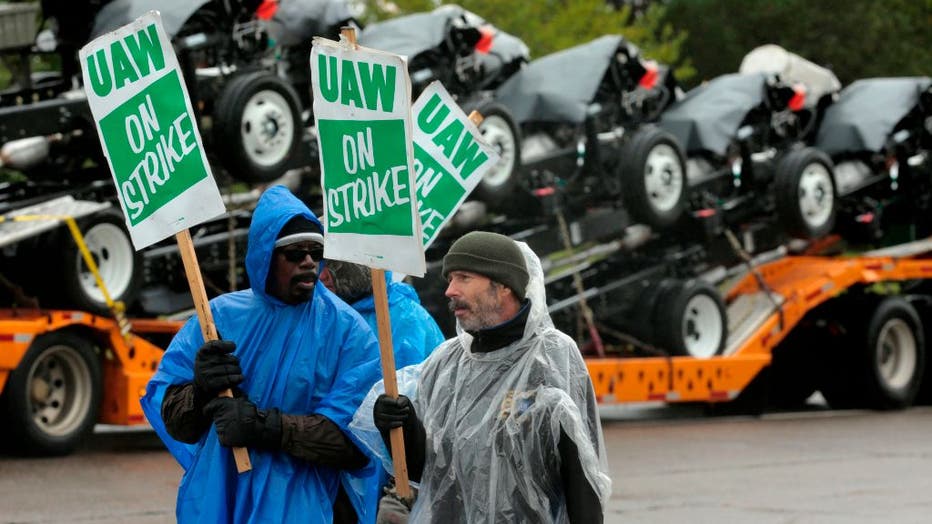UAW could strike against Detroit's Big Three for first time ever
Will UAW, Big 3 reach compromise before strike deadline?
With two days left before UAW members will strike, the Big Three and the union continue negotiating in hopes of reaching a deal and avoiding the picket line. So far, the automakers' offers have fallen short. Will they reach an agreement before the deadline?
DETROIT (FOX 2) - The reality of a strike by the United Auto Workers against Detroit's Ford, Stellantis, and General Motors for the first time in history is getting closer and closer to reality. A strike starting at midnight on Friday could happen, and it could drag on for weeks.
The current agreement between the union and Detroit's Big Three is 11:59 p.m. on Thursday, Sept. 14 and UAW President Shawn Fain has been adamant that, without a deal in place, the union will strike.
"We want a deal, we're ready for a deal, but it has to be a deal that honors our members' sacrifice and contributions," Fain said last week. "The cost of a strike might be high, but the cost of not striking is higher."
Fain has called Sept. 14 the deadline and not a reference point – indicating that any kind of tentative deal is not likely ahead of the 11:59 p.m. deadline.
What is the UAW asking for?
The UAW is seeking a new deal for the first time since 2019 and is asking for a 46% wage increase, a 32-hour workweek, and more for members.
In response to the list of demands from the union, Detroit's Big Three have offered their own proposals:
So far, GM has offered 10%, Stellantis, offered 14.5%, while Ford proposed a 9% wage increase and a 6% lump sum added after.
Fair has called the offers "shameful and insulting" and "deeply inadequate."
What does the UAW want from Detroit's Big Three in the 2023 negotiations?
What makes this UAW negotiation different?
The UAW was founded in 1935 in Detroit and has gone on strike multiple times in the past 90 years.
However, there are major differences between this potential work stoppage and previous strikes - namely in the number of automakers involved.
Since the 1940s, the UAW's strategy has been to negotiate with at least three automakers at the same time – but separately. Then it could come down to one automaker to target for final stages of negotiations. Then that deal would be used as a model for the remaining automakers. They wouldn't be the exact same – but they'd be models.
This year, Fain has put the three automakers on notice that there is not a single company they're targeting. Rather, they're working to get a deal for all workers.
Why does the UAW target one company?
This was started under UAW President Walter Reuther in the 1940s. He was elected president in 1946 and served until his death in 1970. When he was elected, there was a push for a "30-40" among workers (a 30-hour week for 40 hours of pay). He rejected it and instead accepted management's argument that shorter hours conflicted with total wage increases and other benefits.
During his time, he concentrated on total annual wages and started negotiations with one company. He would pick one of the Big Three and, if no concessions were offered, he would strike it.
This became the traditional negotiation for the past 60 years – until 2023 when Fain bucked the tradition.
When was the most recent UAW strike
The UAW most recently went on strike in 2019 against General Motors. UAW members at the GM facilities went on strike for 40 days. Ford and Stellantis - then FCA - were not impacted by the strike and operations continued.
The strike started on Sept. 15, 2019 and dragged on until Oct. 25 when the UAW's 49,000 GM workers agreed to ratify the deal that included lump-sum payments, as well as an $11,000 signing bonus – while allowing GM to close three factories that were making slow-selling cars.
Strike pay and benefits for UAW members if no deal is reached

United Auto Workers (UAW) members picket outside of General Motors Detroit-Hamtramck Assembly in Detroit, Michigan, as they strike on October 16, 2019. - Leaders of the United Auto Workers union announced October 16, 2019, they have reached a tentati
When was the first UAW strike?
UAW members first went on strike in November 1936 in Indiana against the Bendix Products Corporation. At the time, sit-down strikes had become a popular way to leverage worker activism and gain rights in the workplace but the Bendix strike had a major impact as it led to the sit-down strike in Flint a month later.
The union held out for 8 days until an agreement was reached. Members went on strike during a bitter cold snap and the company turned off the heat to the plant, trying to freeze out the members.
The UAW eventually came to an agreement and went back to work.
Autoworkers at General Motors applied the same strategy in Flint the next year – prompting GM to become the first of the Big Three to recognize the UAW.

